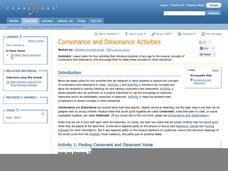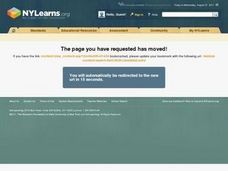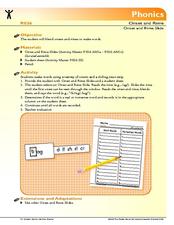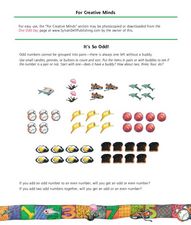Curated OER
Barter vs. Money
First graders listen to the book, Sheep in a Shop, that leads them to think about making financial decisions, trading, and the barter system. After the book is read aloud, a discussion ensues about some of the things that the sheep...
Desert Discovery
Leaping Lizards
Here is a fine biology lesson that introduces youngsters to reptiles. They study their feeding habits, their habitats, and the adaptations they must make to survive in their environments. The outstanding lesson includes two excellent...
Oklahoma State University
A Hundred Bales of Hay
This lesson combines math, visual arts, and language arts activities that all focus on the making, and baling of hay. The activities can be adjusted to address different age ranges. Most of the activities focus on gaining...
Curated OER
What Can I Do?
Students identify how they are feeling and deal with feelings constructively. In this conflict resolution lesson plan, students explore their feelings through discussion. Students read and complete the What Can I Do? e-sheet. Students...
Curated OER
Pumpkins
The pumpkin might be the single most amazing plant for youngsters. It's so big! It's leaves, it's stems, it's fruit! And it is easy to grow! This instructional activity describes all sorts of wonderful pumpkin ideas. Everything from...
Curated OER
Adapting the Game Concentration
I love classroom games, and this plan deftly describes how you can use the game Concentration across the curriculum to reinforce skills. I wish I would have thought of this when I was teaching this age level. These kinds of games are...
Curated OER
Grow a Musical Instrument
Music, culture, social studies, and plant growth all in one! Kids explore the various type of traditional African instruments that are made out of gourds. They then grow their own gourds and use them to create a wide variety of African...
Curated OER
Lesson 6: Mittens, Socks, Mittens, Socks, Mittens!
Mittens and socks, two of my favorite clothing items! Young learners with special needs, explore clothing appropriate for cold weather. They identify both socks and mittens, discuss weather appropriate clothing, and listen to the story,...
Curated OER
Consonance and Dissonance Activities
Hone those musical ears to identify consonance and dissonance in music being played live or on a recording. Learners will work through four activities where they will listen to consonant and dissonant notes being played first by the...
Curated OER
Pesticide Watch Card
Young scholars examine human health by identifying dangerous pesticides. In this agriculture lesson, students research the food production system in the United States and discuss dangers such as pesticides, chemicals and insecticides...
Curated OER
What is the Setting of a Story?
First graders explore the concepts of what setting is and how it's determined in a story. They play the KidWorks program to help facilitate the setting in a story. They use resources such as a picture dictionary or word wall to find and...
Florida Center for Reading Research
Picture the Word
This is an excellent way to make onset and rime visual for beginning readers. They examine CVC-word picture cards that are all missing the first letter. Using plastic letters (or whatever you have), they complete each word and record it...
Florida Center for Reading Research
Onset and Rime Slide
Discover onset and rime blends using this interactive activity which will appeal to your kinesthetic learners. Using the sliding templates provided, budding readers try different onsets with each rime. They practice reading skills by...
Florida Center for Reading Research
Word Steps
Blending basic CVC letters to make words is one of the first steps to independent reading. Provided here are several images of stairs and several letters to cut and arrange. The learner rearranges the letters to form CVC patterns, sounds...
Florida Center for Reading Research
Syllable Hopscotch
Let your little learners move while they practice breaking words into syllables or chunks. Place a hopscotch "board" on the floor (this can be done with tape). Your class takes turns choosing picture cards, and then they say the name of...
Florida Center for Reading Research
Treasure Chest
Segmenting and blending phonemes helps budding readers understand words. Use this strategy in an engaging game where partners test each other's auditory processing using familiar words. Using picture cards and a chart (included),...
Florida Center for Reading Research
Letter Recognition: Poetry Pen
It's always nice to have a great idea and all the tools to make it happen. The class can use these nursery rhyme and alphabet cards to teach each other letter recognition and letter sound correspondence. There is a full set of alphabet...
Florida Center for Reading Research
Letter-Sound Dominoes
What do dominoes and phonemes have in common? Quite a bit in this engaging phonics game! Each domino has a letter on one side and an image on the other. Everything you need is here; partners place the starting domino on the table then...
Florida Center for Reading Research
Rhyming A-LOT-OH!
Rhymes are a great way to help your scholars with phonemic awareness and word relationships. Kids work with partners to match cards from a stack to their rhyming counterparts on a game board. There are six different boards, so this will...
NTTI
What Size Is It Anyway?
A fabulous plan on teaching basic concepts of measurement to young learners. Pupils use nonstandard units to measure length, practice using a ruler and a yardstick, compare the length of two objects, and perform estimations of length....
Houghton Mifflin Harcourt
Ten More, Ten Less
Six story problems needing answers await your class. Pictures provide some scaffolding, but consider also using unit cubes and 10-rods to compose and solve equations for each. Some of the problems require a two-step processes to solve. A...
NTTI
Putting Together Ten
Groups explore sets of 10 items in two varieties (i.e. 3 white buttons and 7 black ones, or 5 bears and 5 bunnies). They brainstorm about their objects, write math sentences to represent what they have, and report their discoveries to...
Sylvandell Publishing
It's So Odd!
Some resources are just wonderful for stimulating creative thinking and concept understanding. Children are encouraged to explore odd and even numbers through a variety of creative activities. They group items, read a story, make an...
Curated OER
Two Greedy Bears
Improving listening comprehension skills is the goal of this language arts lesson. Young readers listen to the story Two Greedy Bears, stopping to have discussions with a partner. They predict outcomes and make inferences based on...

























